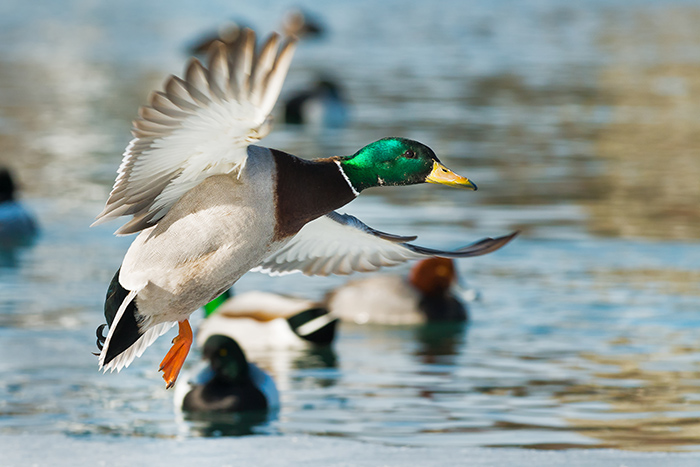Waterfowl Hunting Iowa

Opening day of Iowa’s waterfowl season is more than just a date; it’s a revered tradition for hunters. It embodies the exhilaration of the pursuit and, of course, feeding our families from the wild. Yet, no one seeks to spend a crisp morning gazing at an empty expanse of sky. Success hinges on meticulous planning and finding where the birds congregate.
For those seeking prime locations, the Iowa Sportsman Atlas serves as an indispensable guide, detailing public hunting areas and unveiling new prospects for your waterfowl expedition. While certain locales consistently yield results, truly mastering opening day requires preparation, scouting, and understanding the patterns of waterfowl. Ultimately, a successful hunt lies in your ability to be where the birds are.
Waterfowl Hotspots in Iowa
Iowa’s landscape is dotted with exceptional waterfowl hunting destinations. Along the state’s eastern border, the Mississippi River Wildlife Refuges stand as a vital migration corridor. You can count on diverse hunting for all kinds of waterfowl and Canada Geese in its backwaters, sloughs, and numerous islands. On the western side of Iowa, the Missouri River Wetlands become particularly productive during migration peaks, with their flooded fields and backwater marshes acting as magnets for waterfowl.
Southern Iowa is home to Rathbun Lake, a large reservoir that consistently provides excellent hunting for both geese and a variety of duck species. Near Des Moines, Saylorville Lake emerges as a central Iowa hotspot, drawing in a diverse range of waterfowl, including both diving and dabbling ducks. In northern Iowa, Clear Lake attracts substantial flocks of ducks and geese throughout migration, while Spirit Lake, though potentially a longer journey for some, is also recognized for its consistent duck populations. Rice Lake in Winnebago County, a shallow 1,000-acre lake, is hard to beat during the early season. Its shallowness means it freezes earlier than larger, deeper lakes, but this also makes it an ideal stopover for ducks migrating south from the North before the full freeze-up.
Lake Red Rock, one of the bigger lakes in Iowa, can have good duck hunting when conditions align. A significant draw for duck hunters is the Odessa Wildlife Area, also known as Lake Odessa, situated where the Iowa and Mississippi rivers converge; this area is renowned for holding vast numbers of ducks during their fall migration. Further north, the Union Hills Wildlife Management Area features expertly managed wetlands and marshes that reliably attract ducks. Central Iowa’s Otter Creek Marsh Wildlife Area offers varied habitats, making it a versatile and appealing location for duck hunters. Finally, in the southwest corner of the state, the Riverton Wildlife Area is known for holding a significant concentration of birds.
Private Land
There’s nothing quite as frustrating as putting in the effort on public land—waking before dawn, securing your prime scouted spot—only to have latecomers roll in right at shooting light or set up uncomfortably close. For this reason, you might try to secure some private land. Most of us naturally picture waterfowl hunting in vast marshes or open water, but one of Iowa’s best-kept secrets lies in its private ponds. When it comes to chasing ducks and geese, many hunters overlook the simple act of knocking on doors and respectfully asking for permission. You might be surprised how often landowners are willing to grant access to their ponds, creeks, or river access points. These smaller, often unpressured locations can be incredibly productive.
More Pointers for Success
Once you’ve identified potential hunting grounds, both public and private, the next crucial step is scouting. It’s wise to scout as close to opening weekend as possible. Remember to scout smart: the closer to the season opener you are, the more accurate your intel will be, minimizing the chance of bird patterns shifting. Pay close attention to the wind direction, observing where ducks are approaching from and precisely where they land. Weather is your true secret weapon—learn to harness the wind and sun to your advantage. Ideally, you want the wind at your back or from the side, and definitely not the sun blinding you from the front.
Consider finding a buddy or mentor. Learning from someone with more experience can significantly shorten your learning curve and help you get on the birds faster, saving you from a lot of trial and error. Beyond that, one of your absolute top priorities should be concealment. Make sure to camouflage yourself, your face, your guns, and even your boat.
Finally, keep a close eye on the forecast for harsh weather events. These conditions can dramatically impact waterfowl, scattering them or funneling them into unexpected areas. If you see a storm rolling in, that could be the “edge” you need, and can end up being a perfect day for waterfowl movement. Such disruptions to the usual migration patterns are exactly what seasoned waterfowlers hope for, as they can sometimes push thousands of ducks and geese south in a matter of hours, seeking refuge from the storm. Good luck this season, and above all, be safe!
By Shannon Rivers
September 2025
Here is some gun dog gear to make sure to have.
Here is this month’s digital version of the Iowa Sportsman
Here is the Cattle/Dairy side of things


